Etienne Carajat Paintings
Étienne Carjat was a French journalist, caricaturist, and photographer, primarily known for his work as a portrait photographer. Born on March 28, 1828, in Fareins, France, Carjat moved to Paris to pursue his career. While his initial foray into the arts was through poetry and caricature, he quickly established himself as a prominent figure in the bohemian circles of Paris.
In the 1860s, Carjat co-founded the magazine 'Le Diogene,' where he published his caricatures. However, it is his contribution to photography that has left a lasting impact. He was particularly adept at capturing the essence of his subjects, who were often notable figures in the arts and politics. Among his most famous works is the portrait of the poet Arthur Rimbaud, taken in October 1871, which remains one of the most iconic images of the poet.
Carjat's studio became a meeting place for the Parisian intellectual elite, where artists, writers, and actors frequently gathered. His portraits were celebrated for their ability to convey the personality and spirit of the individuals he photographed. Unlike many of his contemporaries, Carjat preferred natural light and was known for his technical skill and artistry.
Despite the success, Carjat's career as a photographer was relatively brief. He closed his studio in the late 1870s, possibly due to the financial burden of his magazine ventures or a shift in his interests. Nevertheless, his photographic legacy continued to influence the field, and his portraits remain a valuable historical record of 19th-century French cultural figures.
Carjat passed away on March 19, 1906, in Paris. Although not as well-known today as some of his contemporaries, his work has been preserved and is still studied by art historians and photography enthusiasts. His contributions to the art of caricature and his pioneering photographic techniques have secured him a place in the history of French art and culture.

